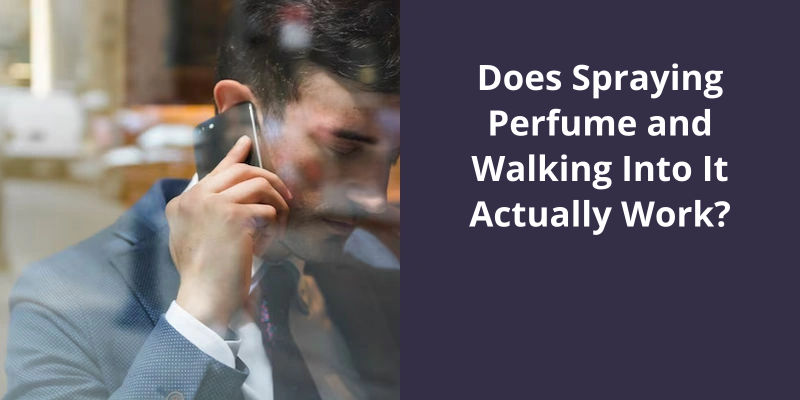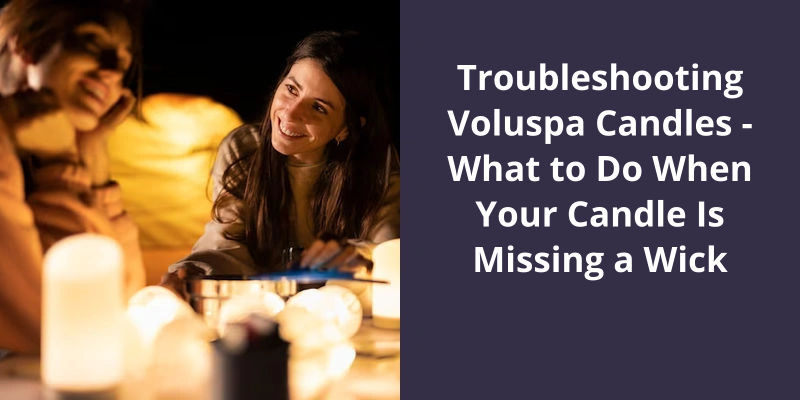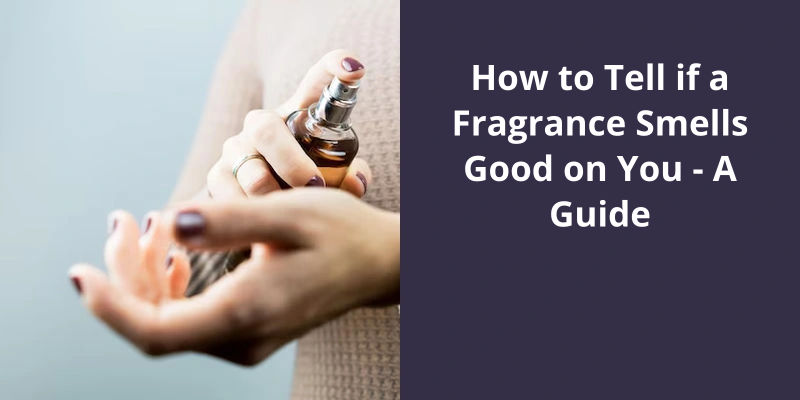The act of spraying perfume into the air and then walking into the mist may seem like a glamorous and indulgent way to envelop oneself in a fragrance, but does it actually work? This seemingly whimsical method of application raises several questions. Is it an efficient way to ensure the fragrance lingers on the skin? Does it waste precious drops of perfume in the process? And most importantly, does it maximize the scent's potency? As we explore these points, it becomes clear that this approach may not be the most effective way to apply fragrance. Instead, we will delve into alternative methods that not only avoid unnecessary waste but also guarantee a longer-lasting and more pronounced olfactory experience.

What Happens to Perfume in Air?
The fragrance molecules in the perfume are lightweight and volatile, meaning they easily evaporate into the air. As the perfume particles disperse, they interact with the surrounding air molecules, causing them to move and spread throughout the space. This movement allows the scent of the perfume to be detected in different areas of the room.
When you walk into the sprayed perfume, the fragrance molecules that are suspended in the air come into contact with your body. Some of these molecules may adhere to your skin, hair, or clothes, enhancing the scent on your body. The warmth of your skin can also help to activate and release the fragrance more prominently.
However, it’s important to note that spraying perfume and walking into it may not necessarily have a significant impact on the overall distribution of the scent in the room. The dispersion of the fragrance molecules is largely determined by factors such as air circulation, temperature, and the volatile nature of the perfume itself.
Additionally, the effectiveness of this method can also depend on the concentration and quality of the perfume. Higher quality perfumes tend to have more long-lasting scents, while lower quality ones may dissipate more quickly.
In some cases, using larger quantities of perfume or applying it directly onto your skin can lead to a more noticeable and long-lasting fragrance presence. However, it’s always advisable to use perfumes and colognes in moderation to avoid overwhelming others or causing allergic reactions.
Factors Affecting the Dispersion of Perfume in the Air (e.g. Air Circulation, Temperature, Humidity)
- Air circulation
- Temperature
- Humidity
Not only does placing perfume on your ankles add an alluring touch to your fragrance routine, but it also serves a practical purpose. By applying perfume to this area, you ensure that your partner catches whiffs of your enticing scent, even when they’re closer to your pleasure points rather than your typical fragrance zones like the neck and wrists. Discover the significance behind this lesser-known perfume technique and how it can enhance your overall olfactory experience.
What Is the Meaning of Putting Perfume in Ankle?
Spraying perfume and walking into it’s been a popular technique among fragrance enthusiasts for decades. The concept behind this method is to create a gentle cloud of scent that surrounds your body, ensuring that the fragrance lingers in the air and on your clothing. However, the idea of specifically targeting the ankles may be lesser-known but equally intriguing.
In the realm of seduction and intimate experiences, fragrance plays an essential role in enticing and captivating others. The fragrance diffuses upward, enveloping you in an alluring aura that can heighten the senses and create a memorable olfactory experience for both you and your partner.
However, there are alternative methods that allow you to enjoy your perfume without worrying about potential stains or damage.
Can You Spray Perfume in the Air?
When it comes to spraying perfume and walking into it, opinions seem to be divided. Some people swear by this method, claiming that it helps to disperse the scent evenly and create a cloud of fragrance around them. However, experts advise caution when using this technique, as it can have some unintended consequences.
According to fragrance experts, spraying perfume into the air can lead to wastage as a significant portion of the scent might end up being dispersed into the atmosphere. Additionally, the fragrance can settle on surfaces such as clothes, furniture, and floors, potentially leaving stains and residue behind. This is especially true for perfumes that contain oils or colorants, as these ingredients can be difficult to remove and may cause damage.
Furthermore, if your perfume contains alcohol, spraying it directly onto your hair can have drying effects. The alcohol in the fragrance can strip away the natural oils of your hair, leaving it dry and brittle. To avoid this, it’s recommended to spray perfume onto your skin instead of your hair, as the scent will naturally diffuse upwards, enveloping you in fragrance without the need for direct contact.
If you prefer a more subtle approach, applying perfume to pulse points is a tried and tested method. These areas, such as the wrists, neck, and behind the ears, naturally emit heat, helping the scent to radiate and last longer. By dabbing or spritzing perfume onto these pulse points, you can ensure that the fragrance remains close to your body and isn’t easily dispersed into the air.
Additionally, the porous nature of fabrics absorbs and holds fragrance molecules, allowing them to slowly release over time. This means that perfumes applied to clothes can continue to emanate their subtle scent throughout the day, providing a lasting freshness.
Does Perfume Last Longer on Skin or Clothes?
When it comes to the longevity of perfume, the choice between applying it on skin or clothes can make a significant difference. While the skin provides direct contact and immediate diffusion of the fragrance, the porous nature of fabric allows for a slower and more gradual release of scent. This difference in scent diffusion is primarily due to the various properties of skin and fabrics.
Despite these advantages, it’s important to exercise caution when applying perfume directly to clothes. Certain fabrics may react to the chemicals in the perfume and result in staining or discoloration. It’s recommended to do a patch test on an inconspicuous area before applying perfume to your clothes to avoid any potential damage.
However, it’s always essential to ensure that the perfume you choose is compatible with the fabric to avoid any unfortunate mishaps.
How Different Fabric Types Can Affect the Longevity and Intensity of Perfume
- Cotton: Lightweight and breathable fabric that allows perfumes to disperse easily, but tends to absorb and dissipate scents quickly.
- Silk: Smooth texture retains perfume molecules for longer, enhancing fragrance longevity. Provides a gentle and luxurious scent experience.
- Linen: Similar to cotton, it absorbs scents well, but may not hold fragrance as long due to it’s natural tendency to resist moisture.
- Wool: Known for it’s warmth, wool can help perfume notes release slowly, resulting in a longer-lasting scent. However, it may also trap scents, leading to potential blendings.
- Synthetic Fabrics: Materials like polyester and nylon have low absorption rates, causing perfumes to linger on the surface for more extended periods.
- Blended Fabrics: Fabrics made from a combination of natural and synthetic fibers can have varying effects on perfume longevity depending on their composition.
However, this method of spraying perfume and walking through the mist may not be the most effective way to apply fragrance. While it’s a popular technique, there are alternative methods that can provide better results in terms of longevity and scent projection.
Should You Spray Perfume and Walk Through?
Should you spray perfume and walk through? The debate over this perfuming technique has been going on for years. Some swear by it, claiming that walking through the mist of perfume evenly distributes the fragrance over their bodies, creating a lingering and appealing scent. Others dismiss it as a myth, arguing that it’s a wasteful practice and that the perfume evaporates before it’s a chance to adhere to the skin.
Those in favor of the spray-and-walk technique argue that it allows for a more even distribution of the fragrance.
On the other side of the argument, some perfume enthusiasts believe that the spray-and-walk method is ineffective and wasteful. They argue that the fine mist of perfume evaporates quickly, preventing it from properly adhering to the skin. They suggest that it’s better to target specific points on the body, such as the wrists, neck, and behind the ears, where the warmth of the skin can help to amplify and prolong the scent.
Some perfumes may perform better with this method, while others may be better suited for targeted application. Experimentation and finding what works best for you is key.
Spritzing perfume rather than misting it in front of you and walking through the cloud seems to be a more reliable method for fragrance application. By targeting specific points on the body with a controlled spray, you can ensure that the perfume has a chance to properly adhere and develop it’s scent over time. However, if you enjoy the ritual of walking through the mist, then embrace it and enjoy the olfactory experience it provides. Remember, the most important thing is to wear perfume in a way that makes you feel confident and enhances your personal style.
Conclusion
While it may create a momentary cloud of fragrance, the efficacy of this technique is questionable at best. Perfume is designed to be applied directly onto the skin, where it can interact with the body's warmth and chemistry to enhance it’s aroma and longevity. By spraying perfume into the air and simply walking through it, a significant amount of the fragrance is wasted, as it disperses into the surrounding environment rather than being absorbed by the skin. Furthermore, the delicate components and nuances of the fragrance may be lost in this process, diminishing the overall olfactory experience. Instead, it’s advisable to apply perfume directly onto pulse points, such as the wrists, neck, and behind the ears, where the skin is warmer and can intensify the scent. This method not only optimizes the usage of the fragrance but also ensures a more intimate and long-lasting experience.





